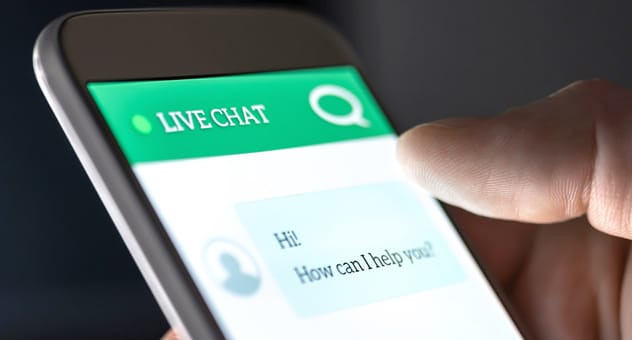

The last time I used live chat, it was to contact a large online train ticket provider, to claim a refund after my train got cancelled.
The session started well, with a cheery promise from the customer support agent to sort my refund quickly. But it soon descended into a vortex of misunderstanding and referrals to procedures so complex they would have made Franz Kafka proud. The exchange took over 40 minutes and I still ended up with the wrong information. The only way I managed to get anywhere was to call the company directly.
Where does it all go wrong?
Why is it so difficult to get live chat right? It’s not as if we have to imagine what it feels like to use it. We’re all customers, after all. Anyone in a customer service role will probably have used it as a consumer themselves at least once in the last six months. Contact numbers are vanishing rapidly from company websites altogether, replaced by a little box in the bottom right-hand corner. So most of us are all too familiar not just with using live chat but with what it feels like when it goes wrong.
The answer to this question lies in a truth that, though blindingly obvious, still needs stating. And that’s that the technology we’re dealing with here has been spectacularly misnamed. ‘Live chat’ implies that we’re actually speaking to someone when we use it. But we’re not chatting at all, are we? We’re writing.
Human wiring
This matters a lot more than you might think. When you hear a human voice, neural circuits start firing off all over your brain. Hormones are released. There’s even an area of the brain dedicated to this: it’s called the voice processing area. It responds to the human voice but to no other sound. And the reason for this is that our brains are wired to talk.
Talking is very, very old technology as far as our biology is concerned. The structures that we use in our brains for processing the human voice have evolved over hundreds of millions of years. We’ve been using sound to communicate since we crawled out of the swamp, and even before. Palaeontologists have found some of these structures in the fossils of fish.
Your voice can convey so much. Even silences are important. Elizabeth Stokoe, professor of psychological and behavioural science at London School of Economics and Political Science, explains that even the smallest delay can have a real significance. If you say ‘hello’ when you answer a phone call and the other person takes more than seven-tenths of a second to respond, your brain will tell you that something’s wrong. Just one tenth of a second longer and your brain knows that all is not well.
We all also innately recognise the expressive powers of tone. One single syllable – ‘Hey!’ – could be said as a warm greeting or in surprise, anger or alarm, and on hearing it, we’d recognise which instantly. It’s not what you say, it’s the way that you say it – you can even hear when someone is smiling as they speak over the phone. It’s incredible.
This biology of our brains means that when we invite our customers to ‘chat’ with us, we’re not just at risk of deceiving ourselves. We’re forcing both parties to rely on what is essentially an unnatural mode of communication. And that’s because our brains did not evolve to read and write, but to speak and listen.
Fighting evolution
Live chat may be a recent development, but so is writing, in the grand scheme of things. We’ve been doing it for less than five and a half thousand years. While that might seem like a very long time, it’s just a heartbeat in evolutionary terms.
We still have our Stone Age brains. So when we learn to read and write, what we are actually doing is performing a miracle of human adaptation, cobbling together parts of the brain that evolved for completely different purposes.
Reading involves not just the visual cortex but the auditory cortex, too. You ‘hear’ the words you’re reading. (That’s why you might mistype words that sound similar but mean completely different things, such as ‘sight’, ‘site’ and even ‘side’.) The brain is translating dots and squiggles on a screen to a voice in your head.
We’re born immediately able to communicate with sound, long before we acquire formal language. A crying baby is harder to ignore than toothache. And often all it takes to soothe her is the sound of a parent’s voice.
A complex brain hack
Learning to read, on the other hand, takes years. That’s largely because it requires a physical change in our brain’s biology, not just developing processes but growing new nerve connections between parts of the brain that would not naturally be joined.
The story doesn’t end there, though. Reading and writing will always be a complex hack. The fact that we usually do them without thinking is a testament to the amazing power of the human mind. But it’s still essentially a hack. It takes more energy and concentration than we realise. Often, we’re operating at the limits of our capacity. (You’ll know this if you’ve ever found yourself turning off background music when you were reading a difficult passage of a report or article. In that case, the music tipped you over the edge.)
This is one reason that text-based interactions can go so wrong. Our brains are fully occupied when we read: we’re not just concentrating on understanding the words but trying to interpret tone, too. So we have little capacity left, including for emotional control.
Losing the voice
Nuance is often lost and the potential for misunderstanding is enormous. The voice in your head is trying to reproduce not just how the words you’re reading normally sound but how they sounded in the writer’s head (or, in this case, the customer’s). This makes writing hopeless for handling difficult situations or anything emotive. And that includes trying to persuade an angry customer not to cancel their subscription.
This applies to what you’re typing, too. Of course, in any kind of writing, there’s no actual ‘voice’. When you’re tapping away, you hear your own voice: you hear what you mean to say, how you mean to say it. But the person at the other end can’t hear any of that. They just see the dots and squiggles, and they have to do the hard work of translating those into words with their brains.
Then they overlay that with their own mood music. What they read could be very different from what you believe you’ve written. It all depends on their circumstances and their emotional state at the time. But you could well face an uphill battle to change the voice in their head when all you have to do it is the keyboard in front of you.
This happens in other walks of life, too. Have you ever found yourself so exasperated by a text conversation that you decided to call the other person? Usually, things get a whole lot better as soon as you start actually speaking to each other. You can almost feel the relief washing over you: ‘Oh yeah, I see what you mean,’ you say. ‘OK, that’s fine. I get it now.’
A biological disadvantage
That feeling is the result of the release of oxytocin into the bloodstream. Oxytocin is a hormone and a neurotransmitter, governing both how we feel and how we think. It plays a pivotal role in all social interaction. It’s released if you hold a newborn baby. It’s responsible for feelings of attraction and desire. And it’s responsible for feelings of trust and happiness.
Oxytocin is released when you have a conversation – a real one, that is, using your voice and ears. But there’s research evidence to suggest it’s not released when you’re writing.
This is why trying to settle an argument by text message is a bad idea. But it also puts you at an immediate disadvantage if you’re trying to resolve a dispute using live chat. You could be telling a customer that they can’t have what they want – you could be disappointing them. Emotions are running high and, just when you really need oxytocin to smooth things over, it’s not there. You’re missing the biological component that you need – the one that’s released by the voice.
Finally, there’s the fact that live chat is what language specialists call synchronous – in other words, it takes place in real time. That too can lead us to confuse what we’re doing with talking, as it can feel (almost) like a real conversation. Nevertheless, it’s not a real chat. And it’s in the gap between what we think we’re doing and the reality that the dangers lie.
But while science can tell us all the reasons live chat goes wrong, it also holds the key to doing it well.
Getting it right
To make live chat work, we need to see it for what it is: an interaction between two humans. Fortunately, cognitive and social scientists have been studying this for years, even if the wider professional world has remained ignorant of their findings. So here are three key takeaways from their research that can help you get live chat right.
1. Be human
The parts of our brain that govern instant, knee-jerk responses evolved long before our capacity for reason. Our first reaction is usually emotional, even if we’re not aware of it. And, as screens also have an almost unique power to draw us in, we get lost in the moment when we’re online, which also increases our reliance on emotion and on our evolutionary programming.
This is why it’s so important that your first response to the customer should be as a human being. If someone is upset, acknowledge it as you would in real life. Many companies have boilerplate responses that attempt this yet still end up making their agents sound like robots. (Technology may have come a long way, but it still can’t yet replace genuine human empathy.)
There’s a world of difference between ‘I’m sorry to hear that’ and ‘Oh no – that’s awful!’. The first describes a feeling, the second expresses it, as a genuine ally would if they were in the room with you.
It may seem like a small thing, but it’s not. We often use our so-called rational thinking to explain a feeling that we already have. So if it feels like you are genuinely trying to help the customer, that feeling can carry through the conversation and earn you the benefit of any doubt. Those few words (or their equivalent – it’s not a script) can make all the difference.
What you should not do is repeat back what the customer has just told you, despite the common practice of doing exactly that – and often in the customer’s exact words. Just imagine the effect of trying to build empathy with such a crude technique in real life. Why on earth does anyone think it would work online?
And really pay attention to what the customer is saying rather than leaping to a response that doesn’t match it. (I’ve lost count of the times that agents have taken ten minutes or more to acknowledge the issue that I told them about in the first line.)
2. Keep your promises
One of the things we rely on in our first encounter with people is an innate drive to reduce uncertainty. We have a program running in our head that asks: ‘Can I trust this person? Have they got my best interests at heart?’
To answer that question, we rely on subtle cues, generally without even realising we’re doing it. There are two types of these cues, the first of which is easy to fake (such as simply writing that you want to help). We pay less attention to this type.
The important ones – the cues we tend to rely on most when deciding whether we can trust someone – are in the second type. These are often based on behaviour rather than simple, easy-to-write statements. Talk, or chat, is cheap. It’s what you do that counts. And as soon as someone’s brain says ‘no’, there’s generally no going back.
It’s very easy to trigger this uncertainty response and derail the relationship. In live chat, it could even be something as innocuous as saying something will take five minutes and it takes ten, or saying, ‘Oh yes, I can definitely help you with that,’ and then having to transfer the customer to another agent.
While these may seem trivial, you’ve still broken a promise. And these small broken promises will chip away at a customer’s trust.
3. Explain any pauses
Even the timing of our responses can have a huge effect.
If you speak to somebody, you tend to expect a reply straight away. (Remember Professor Elizabeth Stokoe’s findings about silences: a pause of even seven-tenths of a second is enough to make you think something’s wrong.)
This is another place where we run into trouble with live chat, because the customer’s brain still thinks it’s involved in a real-life conversation. If they don’t get a response within even a few seconds, then an internal stopwatch starts ticking. A mere 30 seconds can seem like an eternity.
There might be very good reasons for the pause. The agent may be conferring with colleagues. They could be managing several other enquiries (albeit this is not a good idea anyway). But to the customer, it still feels like an unreasonable and uncomfortable silence. It sends a powerful, subconscious signal to the brain that something’s wrong. At best, the customer is impatient – at worst, they start to get nervous and, again, start to lose trust.
So explain any upcoming pauses to interrupt the customer’s internal stopwatch and let them know you are still working to solve their issue.
This point also means that any delay in answering a query could do lasting damage to a customer relationship. Having a chat box that you can’t answer straight away is arguably worse than not having one at all.
We can’t go back
So, with all that said and so much stacked against it, should we bother with live chat at all? Well, probably yes. We can’t put this genie back in the bottle, but nor should we take it for granted. Besides, we’ve all become so accustomed to typing rather than talking that many customers actually prefer to use live chat rather than calling anyway.
But just because you can type the words in your head and they appear on a screen, doesn’t mean that they’ll have the effect that you think they will. So you need to be conscious of what you’re doing. You need to know the limitations.
The potential pitfalls of live chat all stem from our human brains and human emotions. But being as human as possible is also what will make it work best. So show that there’s a human being behind every chat, because there’s a human being on the other side of the conversation as well.
Your mission is always to bridge the divide between real chatting and this thing we’re choosing to call chat. And if all else fails, just try thinking about how you felt the last time you were on the other end of it.
References
Ellison, NB, et al (2006). Managing impressions online: self-presentation processes in the online dating environment. Journal of Computer-Mediated Communication, 11(2): 415-441.
Seltzer, LJ, et al (2012). Instant messages vs. speech; hormones and why we still need to hear each other. Evolution and Human Behavior, 33(1): 42-45.
Seltzer, LJ; Ziegler, TE; and Pollak, SD (2010). Social vocalizations can release oxytocin in humans. Proceedings of the Royal Society B, 277: 2661-2666.
Stokoe, E (2018). Talk: The Science of Conversation. Robinson.
Image credit: Tero Vesalainen / Shutterstock





